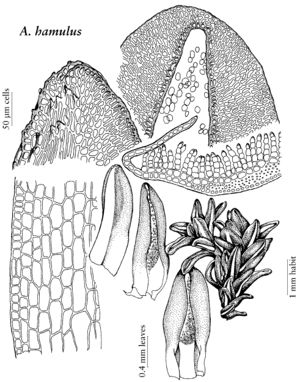Aloina
Bih. Kongl. Svenska Venensk.-Akad. Handl. 6(19): 22. 1882,.
| Taxon | Illustrator ⠉ | |
|---|---|---|
 | Aloina hamulus | Patricia M. Eckel |
 | Aloina rigida var. rigida | Patricia M. Eckel |
Plants in thin turfs or scattered. Stem 0.5–6 mm, central strand present. Leaves forming a rosette, lingulate, suborbicular or deltoid, deeply concave, 0.5–2.8 mm, infolded, partly 2-stratose, base auriculate, sheathing, margins entire to irregularly crenulate distally, apex cucullate, mucronate or piliferous; costa broad, percurrent to long-excurrent, in section hydroids absent, stereid band abaxial, occasionally wanting, filaments present on costa and adjacent 2-stratose area of leaf-blade, filament cells cylindrical to subspheric, thin-walled, terminal cell subspheric to nearly conic, with an apical thickening; cells of leaf base thin-walled, rectangular, sometimes differentiated marginally, medial and distal leaf cells thick-walled, mostly transversely elongated, smooth. Sexual condition monoicous or dioicous, perigonia distinct, with noncucullate unfolded leaves, perichaetia sometimes partly differentiated, the inner leaves with unfolded blades. Seta 4.5–17 mm. Capsule cylindric to ovoid-cylindric, erect or slightly inclined, annulus of 1–2 rows of vesiculose cells, deciduous or persistent, operculum conic to long-rostrate, erect or inclined, peristome generally long and twisted, papillose, with a basal membrane. Calyptra cucullate. Spores spheric, finely papillose, 9–25 µm.
Distribution
North America, Mexico, Central America, South America, Mediterranean Basin, s Africa, Pacific Islands (New Zealand), Australia
Discussion
Species 9 (5 in the flora).
Aloina is sparsely distributed in the New World. It is generally a very distinct genus characterized by differentiated leaf bases, infolded partly 2-stratose laminae, broad costae, and filaments ending in a terminal cell with an apical thickening; the filaments cover the costa and part of the lamina. Plants of Aloina sometimes resemble Indusiella (Grimmiaceae) in habit and general leaf structure although no filaments are found on the leaves of the latter.
Selected References
Lower Taxa
Key
| 1 | Leaf apex piliferous; costa undifferentiated in the distal two thirds, in section with no stereid band, but with a few stereid or substereid cells in mid-costal region. | Aloina bifrons |
| 1 | Leaf apex muticous; costa percurrent to subpercurrent, in section with 1-7 stereid layers | > 2 |
| 2 | Leaf base without a differentiated margin of thin-walled hyaline cells | > 3 |
| 2 | Leaf base with a marginal area of narrow thin-walled hyaline cells | > 4 |
| 3 | Costa with strong solid papillae on the abaxial side at and near the apex; capsule ovoid-cylindric, peristome short (to 900 µm), nearly straight. | Aloina hamulus |
| 3 | Costa smooth abaxially; capsule cylindric, peristome long (600-1200 µm) and twisted. | Aloina aloides |
| 4 | Leaves suborbicular to short-lingulate; synoicous (or dioicous); capsule cylindric, operculum conic to short-rostrate. | Aloina brevirostris |
| 4 | Leaves ligulate; dioicous; capsule ovoid-cylindrical, operculum long-rostrate. | Aloina rigida |